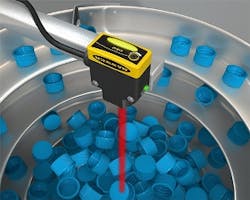Adjustable-Field Sensors
The QS30AFF400 foreground suppression sensor and the QS30AF600 background suppression sensor use advanced linear imager technology to provide a superior sensing solution for myriad industrial applications, including part-in-place detection, feeder bowl control and package detection on conveyors."Our goal in developing the new QS30AF/AFF models is to provide high performance, adjustable-field sensors capable of twice the detection range with less color sensitivity than Banner's previous generation of sensors," said Dennis Smith, technical marketing manager for Banner Engineering. "The use of a 128 pixel camera (linear imager) makes QS30 sensors resistant to mechanical shock and vibration, enabling advanced image processing to maximize the range and minimize the effects of target color. The sensors also have excellent crosstalk immunity and can reject fluorescent or other spurious light signals, allowing multiple Banner sensors to be used in close proximity to one another."The QS30AFF400 sensor offers foreground suppression to deliver reliable detection of target objects varying in color or shape when a fixed background is present. Conversely, the QS30AF600 sensor provides reliable detection of objects when the background condition is neither controlled nor fixed, and it ignores objects located beyond the sensing field cutoff. The sensing range for all models can be adjusted with a screwdriver potentiometer or via the remote teach wire input. Additionally, the sensors’ visible red LED sensing beam ensures easy sensor alignment.The QS30AF/AFF models are available in a waterproof, epoxy encapsulated IP67-rated housing, making them suitable for use in even the harshest of industrial environments. Providing a variety of mounting options, including a 30 mm threaded barrel or side mount, the sensors deliver increased flexibility to meet diverse applications. Three connection options—2 m, 9 m quick-disconnect and 150 mm pigtail quick-disconnect—are also available.Additional features of the QS30AFF400 foreground suppression sensor and the QS30AF600 background suppression sensor include:• Precise and repeatable switch point performance • Enhanced immunity to fluorescent lights and crosstalk of nearby sensors • Large, bright output and sensor status indicators • Four-turn potentiometer or remote teach input to set the switch point distance • Full assortment of convenient brackets and cordsets for simple installation • Models are available with cable or integral metal quick-disconnect or M12 pigtail connectors • Bipolar discrete outputs, PNP and NPN, with optional LO/DO selection in every model The QS40AFF400 model offers an adjustable cutoff range of 50-400 mm, with a maximum sensing range of 400 mm for all sensor colors.The QS30AF600 model delivers an adjustable cutoff range of 50-600 mm, with a maximum sensing range of 400 mm for the 6% black card sensor and 600 mm for the 90% white card sensor. The 6% black card sensor also offers a minimum sensing range—also known as the dead zone—of 30 mm.
Banner Engineering - www.bannerengineering.com

